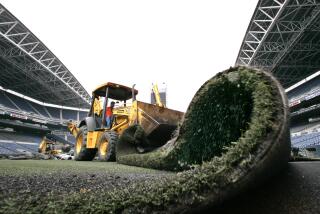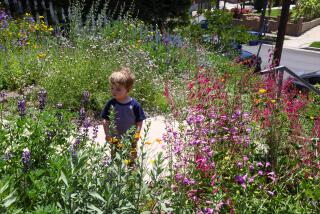Turf scientists on a quest to engineer a superlawn
- Share via
In a parched experimental plot at the edge of UC Riverside, several dozen mounds of grass poke out of the powdery soil.
These plants have the soft, narrow leaf blades and dark-green hue that would make them a welcome addition to any American lawn. Most important, they lack the feature that threatens to doom today’s turf -- an unsustainable thirst for water.
With mandatory watering restrictions turning grass brown from California to Florida to Massachusetts, a small but dedicated cadre of turf scientists is on a mission to engineer a drought-proof superlawn.
They are acutely aware of the technical challenges. Millions of years of evolution have failed to devise a turf that thrives in dry, hot summers and cool, damp winters, and trying to one-up Mother Nature certainly is an exercise in horticultural hubris.
Low water demand is crucial, but it’s not enough. To have a shot at commercial success, the grass also would have to tolerate shade, be resistant to fungi and pests, grow at a relatively slow pace, produce ample seeds and pass down the same characteristics from generation to generation.
It could take years, even a decade -- if the effort succeeds at all. But as water becomes increasingly scarce, researchers say the need for less thirsty lawns is too great to ignore.
“Thirty years from now, it would be nice to say it really did pay off,” said plant geneticist Jason Goldman of the U.S. Department of Agriculture, who has already invested five years in his efforts to create a superlawn in Woodward, Okla.
With California mired in its third year of drought, UC Riverside turfgrass specialist Jim Baird has become another true believer. He hopes his water-wise prototypes will grow up to be the lawns, parks, golf courses and athletic fields of the future.
“My colleagues say I’m crazy,” he said. “But it doesn’t hurt to dream.”
Appearance has always been the most important aspect of American lawns.
Wealthy homeowners began planting them in the 1700s as status symbols to evoke the manicured grounds of English estates. Only the upper class could afford to employ small armies of servants to keep grass trimmed to lawn-level height with hand-held blades.
That changed after the Civil War, when the availability of garden hoses and mechanical push mowers made it possible for regular homeowners to tend to their own lawns. Americans came to favor emerald-green grasses over the apple-green shades that are prized in England.
Today, about 50,000 square miles of lawns, golf courses and parks blanket the U.S., according to estimates derived from NASA satellites. That’s enough to cover the entire state of Mississippi, with some to spare. Keeping all that grass green requires about 200 gallons of water per American per day, NASA scientists have calculated.
Water restrictions make such maintenance increasingly untenable.
As of June 1, the Los Angeles Department of Water and Power limited the use of sprinklers to 15-minute cycles on Mondays and Thursdays. Restrictions are in effect throughout California, as well as Nevada, Minnesota, North Carolina, Florida and other states.
Turf experts recognize that something has to change.
“We need to convince people that in the summer, you don’t need to have a lush green lawn,” said Bingru Huang, a turfgrass physiologist at Rutgers University in New Brunswick, N.J.
Baird -- whose obsession with grass grew out of a teenage interest in golf -- doesn’t think Americans will ever be swayed of any such thing. He believes Americans would sooner rip out their lawns than tolerate months of brown grass in their yards.
“We’re trying our best to ensure we have some turf around,” he said.
Grasses have evolved a variety of strategies for coping with drought.
Some grow deep roots that can reach water far below the surface. Some go dormant and turn brown, preserving their resources until rain returns and conditions are more favorable for growth.
Other plants accumulate sugars and related compounds in their stems and leaves to help them hang on to whatever water they manage to find.
And some minimize water loss during photosynthesis by growing waxy coatings or hair-like filaments that capture water vapor escaping through pores in the leaves. Warm-season grasses such as Bermuda and St. Augustine do a better job than cool-season grasses like Kentucky bluegrass and tall fescue of capturing carbon dioxide without losing water, Huang said.
Most Californians plant tall fescue varieties, such as Marathon, in their yards. They are the most water-efficient of the cool-season grasses, but that still leaves plenty of room for improvement.
Simply switching to warm-season varieties would reduce water needs by 20%, Baird said. However, these species go dormant in the winter, and even during their active months they never reach the deep green hues of their cool-season cousins.
“We could go a long ways in terms of our drought if more people used those grasses,” he said. “But the color issue is the major limiting factor.”
So Baird focuses his energy on a patchwork of grass samples in UC Riverside’s 15-acre experimental plot, the center of academic turf research in the state. They were created by crossing a ryegrass with a variety of meadow fescue.
Ryegrasses have the deep emerald complexion Americans crave, along with other useful traits such as the ability to withstand foot traffic. But they lack tolerance for heat, drought and diseases -- all natural strengths of fescues.
“What we’re doing here is combining the best of both worlds,” Baird said.
The work is tedious. UC Riverside cytogeneticist Adam Lukaszewski began breeding these grasses for drought resistance three years ago by emasculating specified plants with tweezers, then sprinkling them with pollen from designated mates. The resulting seeds were planted in the ground, along with regular ryegrass controls. Once they were established, the water was shut off to simulate drought conditions.
“All the controls started yellowing quickly,” Lukaszewski said. “The others stayed green and stayed green and stayed green.”
Further experiments in the greenhouse and the lab revealed that the most vibrant grasses all shared the same stretch of DNA on the short arm of chromosome 3 that came from fescue.
“If they had it, they made it,” he said. “If they didn’t, they croaked.”
Scientists have not figured out what those genes do. Perhaps they regulate root growth, enabling the grass to reach deeper in the soil under dry conditions. Or maybe they’re involved with the way water is used inside plants, so grass can last longer without irrigation.
Lukaszewski has continued to cross the best of the grasses in the hopes of producing offspring that are even hardier than their parents. Baird put the newest generation of plants in the ground last month. He is optimistic that it could become the grass of choice in California -- and much of the rest of the country -- when it’s ready for public use, which he hopes is only three to six years away.
Grass researchers elsewhere are using similar approaches to develop their superlawn candidates.
At the USDA’s Southern Plains Range Research Station in Oklahoma, Goldman has spent the last five years trying to blend the sumptuous qualities of Kentucky bluegrass with the heat and drought tolerance of Texas bluegrass. He estimates it will take at least six or seven more years to produce a workable hybrid that could grow throughout much of the East and Midwest.
Goldman’s primary focus at the USDA is on developing more nutritious forage grasses for livestock. But his efforts to create a drought-resistant lawn are no less important.
“Especially in this day and age, when water is becoming a big issue everywhere, it’s definitely worth pursuing,” he said.
Researchers at the Rutgers Center for Turfgrass Science -- the top turf program in the nation -- are infusing grasses with heat- and drought-resistance genes from distantly related desert and dryland plants.
To identify useful DNA, they start with plants that can thrive in adversity and look for genes the plants turn on when deprived of water. Those genes can be copied and spliced into bacteria, which then insert the genes into grass. Scientists can also attach the DNA to microscopic gold particles and shoot them into a target turf.
Huang’s lab has isolated a key photosynthesis gene from thermal bentgrass that grows in Yellowstone National Park’s naturally heated soils, and she is trying to transfer it into species such as Kentucky bluegrass. She said she hoped the result would be a lawn-quality turf that could withstand heat with less water. Along with colleagues around the world, she continues to hunt for other useful genes to splice into test grasses.
Any lawn created this way would carry the stigma of being a genetically modified organism, but it could be ready to plant years before anything developed through conventional breeding.
“We want to get something as soon as possible,” Huang said. “I think 10 years is not a problem. Five years might be tight.”
--







